brake light PEUGEOT 508 DAG 2010 Owners Manual
[x] Cancel search | Manufacturer: PEUGEOT, Model Year: 2010, Model line: 508 DAG, Model: PEUGEOT 508 DAG 2010Pages: 330, PDF Size: 11.59 MB
Page 5 of 330
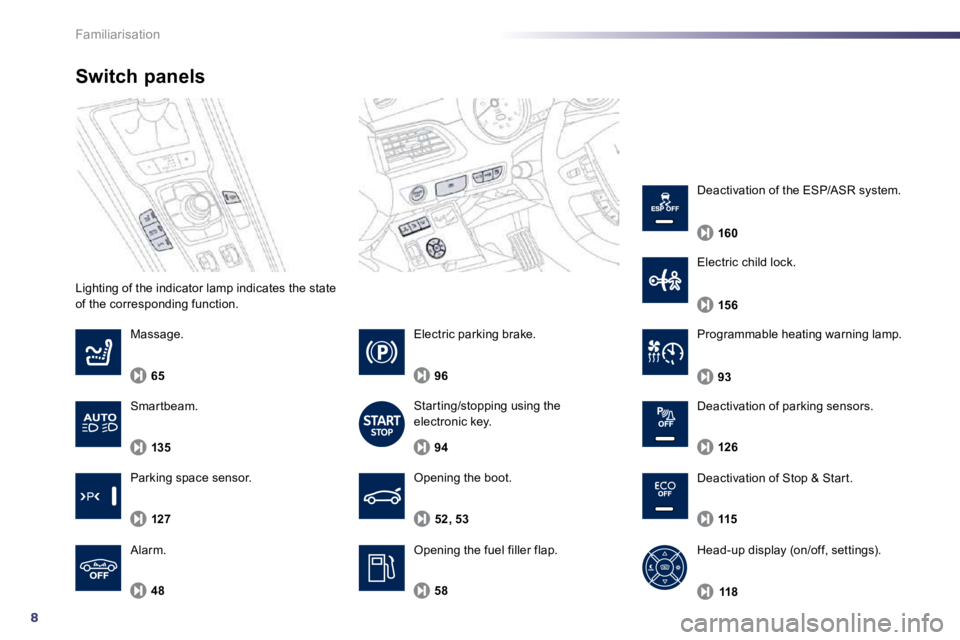
8
Familiarisation
Lighting of the indicator lamp indicates the state of the corresponding function.
Switch panels
Opening the boot.
Opening the fuel filler flap.
52, 53
Massage.
65
48
Alarm.
Programmable heating warning lamp.
58
93
Electric parking brake.
96
Star ting/stopping using the electronic key.
94
Deactivation of Stop & Star t.
115
Head-up display (on/off, settings).
118
Deactivation of parking sensors.
126
Parking space sensor.
127
Electric child lock.
156
Deactivation of the ESP/ASR system.
160
Smar tbeam.
135
Page 7 of 330

10
Familiarisation
9. Fusebox. 10. Front door window demisting/defrosting vent. 11. Windscreen demisting/defrosting vent. 12. Steering lock and star ting with the key. 13. Star ting using the electronic key. 14. Audio equipment steering wheel controls. 15. Wiper/screenwash/trip computer stalk. 16. Central locking and hazard warning buttons. 17. Multifunction screen.
Instruments and controls
1. Cruise control/speed limiter controls. 2. Headlamp height adjustment. 3. Lighting and direction indicator stalk. 4. Instrument panel. 5. Driver's airbag. Horn. 6. Gear lever. 7. 12 V accessory socket USB por t /auxiliary socket. 8. Bonnet release lever.
18. Central adjustable air vents. 19. Passenger's airbag. 20. Side adjustable air vents. 21. Glove box /Passenger's airbag deactivation. 22. Electric parking brake. 23. Central armrest with storage. 24. Upper and lower storage. 25. Audio system. 26. Heating/air conditioning controls.
Page 18 of 330

121
!
Instruments and controls
Indicator and warning lamps
Visual indicators informing the driver that a system is in operation, switched off or has a fault.
When the ignition is switched on
Cer tain warning lamps come on for a few
seconds in the instrument panel and/or instrument panel screen when the vehicle's ignition is switched on. When the engine is star ted, these same warning lamps should switch off. If they remain on, before moving off, refer to the information on the warning lamp concerned.
Associated warnings
The switching on of cer tain warning lamps may be accompanied by an audible signal and a message in the instrument panel screen. The warning lamps may come on continuously (fixed) or flash.
Cer tain warning lamps may come on in one of two modes. Only by relating the type of lighting to the operating status of the vehicle can it be ascer tained whether the situation is normal or whether a fault has occurred.
1
2
2
2
3
3
3
2
3
3
With the vehicle stationar y , use the left hand ar ythumb wheel to move through the menus, so as to configure the vehicle settings (driving and comfor t systems, ...). - Rotation (other than menu): scroll through the list of active functions available, - Press: main menu, confirm the selection, - Rotation (in a menu): move up or down in the menu.
Main menu
Vehicle settings
Screen settings
Preheating/Preventilation
Driving position setting
Unlocking boot only
Driving assistance
Speeds memorised
Rear wipe in reverse gear
Automatic parking brake
Lighting
Welcome lighting
Guide-me-home headlamps
Directional headlamps
Settings
Language
Units
Fuel consumption
Temperature
Colours
3
1
2
2
3
2
3
1
2
Page 19 of 330
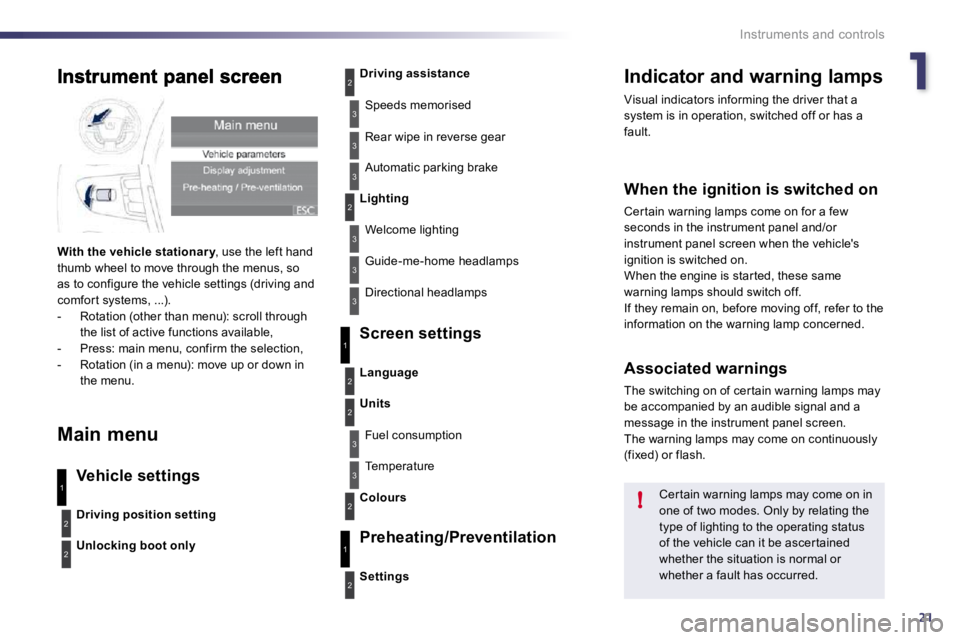
121
!
Instruments and controls
Indicator and warning lamps
Visual indicators informing the driver that a system is in operation, switched off or has a fault.
When the ignition is switched on
Cer tain warning lamps come on for a few
seconds in the instrument panel and/or instrument panel screen when the vehicle's ignition is switched on. When the engine is star ted, these same warning lamps should switch off. If they remain on, before moving off, refer to the information on the warning lamp concerned.
Associated warnings
The switching on of cer tain warning lamps may be accompanied by an audible signal and a message in the instrument panel screen. The warning lamps may come on continuously (fixed) or flash.
Cer tain warning lamps may come on in one of two modes. Only by relating the type of lighting to the operating status of the vehicle can it be ascer tained whether the situation is normal or whether a fault has occurred.
1
2
2
2
3
3
3
2
3
3
With the vehicle stationar y , use the left hand ar ythumb wheel to move through the menus, so as to configure the vehicle settings (driving and comfor t systems, ...). - Rotation (other than menu): scroll through the list of active functions available, - Press: main menu, confirm the selection, - Rotation (in a menu): move up or down in the menu.
Main menu
Vehicle settings
Screen settings
Preheating/Preventilation
Driving position setting
Unlocking boot only
Driving assistance
Speeds memorised
Rear wipe in reverse gear
Automatic parking brake
Lighting
Welcome lighting
Guide-me-home headlamps
Directional headlamps
Settings
Language
Units
Fuel consumption
Temperature
Colours
3
1
2
2
3
2
3
1
2
Page 23 of 330

121
!
Instruments and controls
Indicator and warning lamps
Visual indicators informing the driver that a system is in operation, switched off or has a fault.
When the ignition is switched on
Cer tain warning lamps come on for a few
seconds in the instrument panel and/or instrument panel screen when the vehicle's ignition is switched on. When the engine is star ted, these same warning lamps should switch off. If they remain on, before moving off, refer to the information on the warning lamp concerned.
Associated warnings
The switching on of cer tain warning lamps may be accompanied by an audible signal and a message in the instrument panel screen. The warning lamps may come on continuously (fixed) or flash.
Cer tain warning lamps may come on in one of two modes. Only by relating the type of lighting to the operating status of the vehicle can it be ascer tained whether the situation is normal or whether a fault has occurred.
1
2
2
2
3
3
3
2
3
3
With the vehicle stationar y , use the left hand ar ythumb wheel to move through the menus, so as to configure the vehicle settings (driving and comfor t systems, ...). - Rotation (other than menu): scroll through the list of active functions available, - Press: main menu, confirm the selection, - Rotation (in a menu): move up or down in the menu.
Main menu
Vehicle settings
Screen settings
Preheating/Preventilation
Driving position setting
Unlocking boot only
Driving assistance
Speeds memorised
Rear wipe in reverse gear
Automatic parking brake
Lighting
Welcome lighting
Guide-me-home headlamps
Directional headlamps
Settings
Language
Units
Fuel consumption
Temperature
Colours
3
1
2
2
3
2
3
1
2
Page 25 of 330
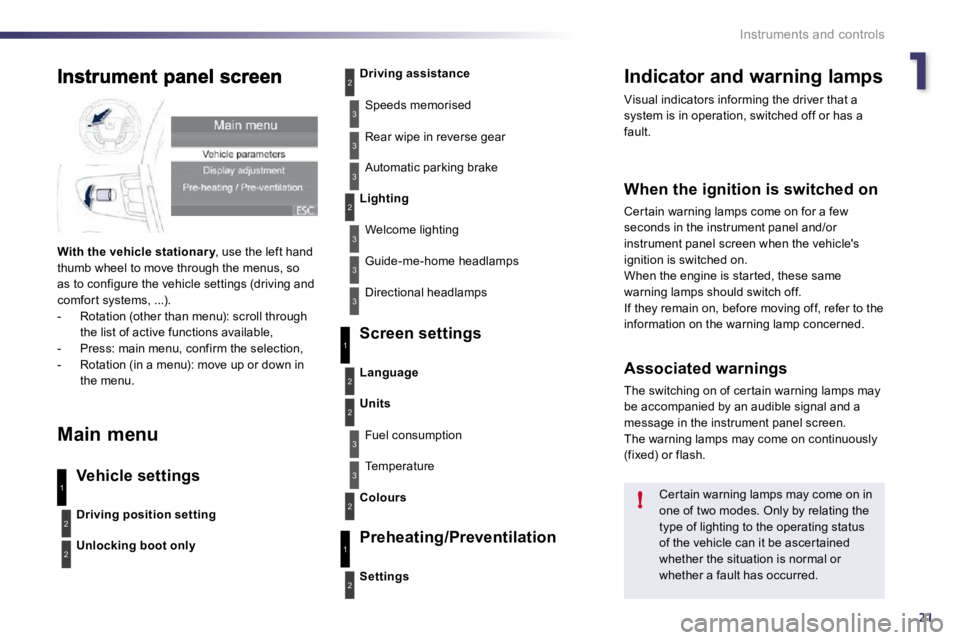
121
!
Instruments and controls
Indicator and warning lamps
Visual indicators informing the driver that a system is in operation, switched off or has a fault.
When the ignition is switched on
Cer tain warning lamps come on for a few
seconds in the instrument panel and/or instrument panel screen when the vehicle's ignition is switched on. When the engine is star ted, these same warning lamps should switch off. If they remain on, before moving off, refer to the information on the warning lamp concerned.
Associated warnings
The switching on of cer tain warning lamps may be accompanied by an audible signal and a message in the instrument panel screen. The warning lamps may come on continuously (fixed) or flash.
Cer tain warning lamps may come on in one of two modes. Only by relating the type of lighting to the operating status of the vehicle can it be ascer tained whether the situation is normal or whether a fault has occurred.
1
2
2
2
3
3
3
2
3
3
With the vehicle stationar y , use the left hand ar ythumb wheel to move through the menus, so as to configure the vehicle settings (driving and comfor t systems, ...). - Rotation (other than menu): scroll through the list of active functions available, - Press: main menu, confirm the selection, - Rotation (in a menu): move up or down in the menu.
Main menu
Vehicle settings
Screen settings
Preheating/Preventilation
Driving position setting
Unlocking boot only
Driving assistance
Speeds memorised
Rear wipe in reverse gear
Automatic parking brake
Lighting
Welcome lighting
Guide-me-home headlamps
Directional headlamps
Settings
Language
Units
Fuel consumption
Temperature
Colours
3
1
2
2
3
2
3
1
2
Page 104 of 330
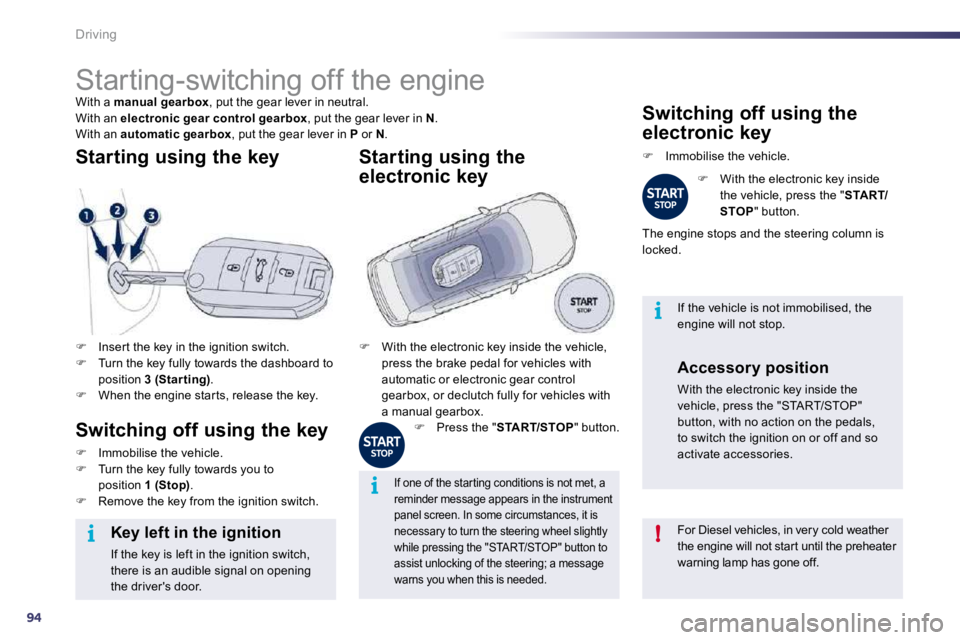
94
i!
i
i
Driving
Starting-switching off the engine
With a manual gearbox , put the gear lever in neutral. With an electronic gear control gearbox , put the gear lever in N . With an automatic gearbox , put the gear lever in P or N .
� Inser t the key in the ignition switch. � Turn the key fully towards the dashboard to position 3 (Star ting) . � When the engine star ts, release the key.
Starting using the key
Switching off using the key
� Immobilise the vehicle. � Turn the key fully towards you to position 1 (Stop) . � Remove the key from the ignition switch.
For Diesel vehicles, in very cold weather the engine will not start until the preheater warning lamp has gone off.
Key left in the ignition
If the key is left in the ignition switch, there is an audible signal on opening the driver's door.
If one of the starting conditions is not met, a reminder message appears in the instrument panel screen. In some circumstances, it is necessary to turn the steering wheel slightly while pressing the "START/STOP" button to assist unlocking of the steering; a message warns you when this is needed.
If the vehicle is not immobilised, the engine will not stop.
� With the electronic key inside the vehicle, press the brake pedal for vehicles with automatic or electronic gear control gearbox, or declutch fully for vehicles with a manual gearbox.
Starting using the
electronic key
� Press the " START/STOP " button.
Switching off using the
electronic key
� Immobilise the vehicle.
� With the electronic key inside the vehicle, press the " START/STOP " button.
The engine stops and the steering column is locked.
Accessory position
With the electronic key inside the vehicle, press the "START/STOP" button, with no action on the pedals, to switch the ignition on or off and so activate accessories.
Page 106 of 330
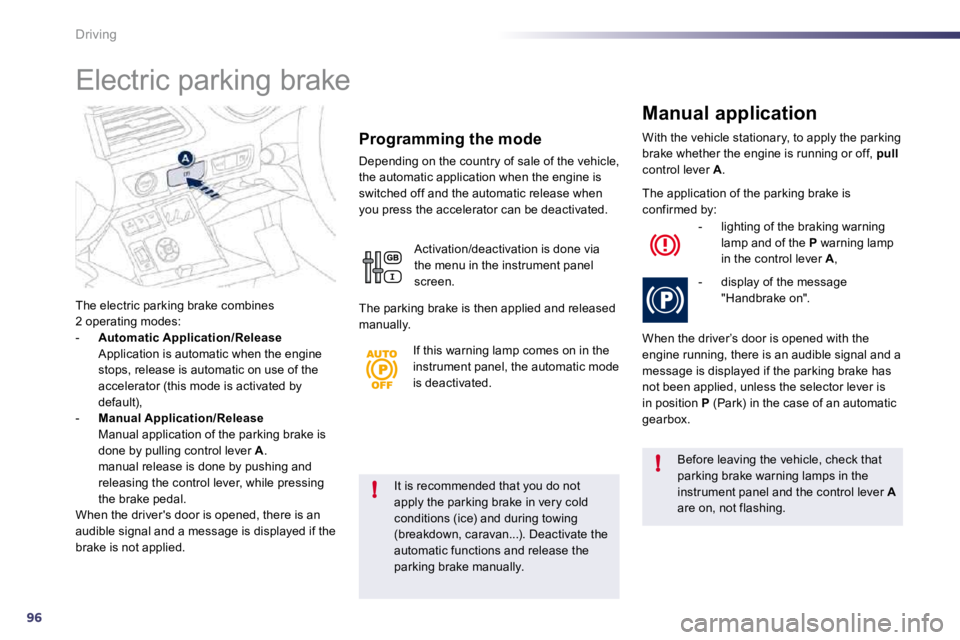
96
!
!
Driving
It is recommended that you do not apply the parking brake in very cold conditions (ice) and during towing
(breakdown, caravan...). Deactivate the automatic functions and release the parking brake manually.
Before leaving the vehicle, check that parking brake warning lamps in the instrument panel and the control lever Aare on, not flashing.
The electric parking brake combines 2 operating modes: - Automatic Application/Release Application is automatic when the engine stops, release is automatic on use of the accelerator (this mode is activated by default), - Manual Application/Release Manual application of the parking brake is done by pulling control lever A. manual release is done by pushing and
releasing the control lever, while pressing the brake pedal. When the driver's door is opened, there is an audible signal and a message is displayed if the
brake is not applied.
Programming the mode
Depending on the country of sale of the vehicle, the automatic application when the engine is switched off and the automatic release when you press the accelerator can be deactivated.
With the vehicle stationary, to apply the parking brake whether the engine is running or off, pullcontrol lever A .
Manual application
Activation/deactivation is done via the menu in the instrument panel screen.
The parking brake is then applied and released manually.
The application of the parking brake is confirmed by:
- lighting of the braking warning lamp and of the P warning lamp in the control lever A ,
- display of the message "Handbrake on".
When the driver’s door is opened with the engine running, there is an audible signal and a message is displayed if the parking brake has not been applied, unless the selector lever is in position P (Park) in the case of an automatic gearbox.
Electric parking brake
If this warning lamp comes on in the instrument panel, the automatic mode is deactivated.
Page 109 of 330
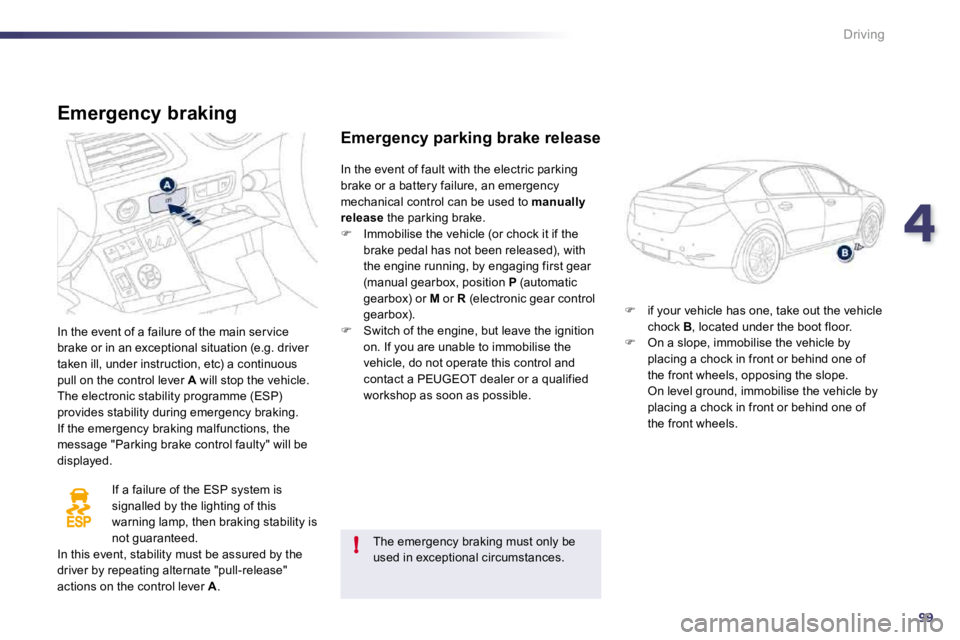
499
!
Driving
Emergency braking
In the event of a failure of the main ser vice brake or in an exceptional situation (e.g. driver taken ill, under instruction, etc) a continuous pull on the control lever A will stop the vehicle. The electronic stability programme (ESP) provides stability during emergency braking. If the emergency braking malfunctions, the message "Parking brake control faulty" will be displayed.
If a failure of the ESP system is signalled by the lighting of this warning lamp, then braking stability is
not guaranteed. In this event, stability must be assured by the driver by repeating alternate "pull-release" actions on the control lever A .
Emergency parking brake release
� if your vehicle has one, take out the vehicle chock B , located under the boot floor. � On a slope, immobilise the vehicle by placing a chock in front or behind one of the front wheels, opposing the slope. On level ground, immobilise the vehicle by placing a chock in front or behind one of the front wheels.
In the event of fault with the electric parking brake or a battery failure, an emergency mechanical control can be used to manually release the parking brake. � Immobilise the vehicle (or chock it if the brake pedal has not been released), with the engine running, by engaging first gear (manual gearbox, position P (automatic gearbox) or M or R (electronic gear control gearbox). � Switch of the engine, but leave the ignition on. If you are unable to immobilise the vehicle, do not operate this control and contact a PEUGEOT dealer or a qualified workshop as soon as possible.
The emergency braking must only be used in exceptional circumstances.
Page 113 of 330
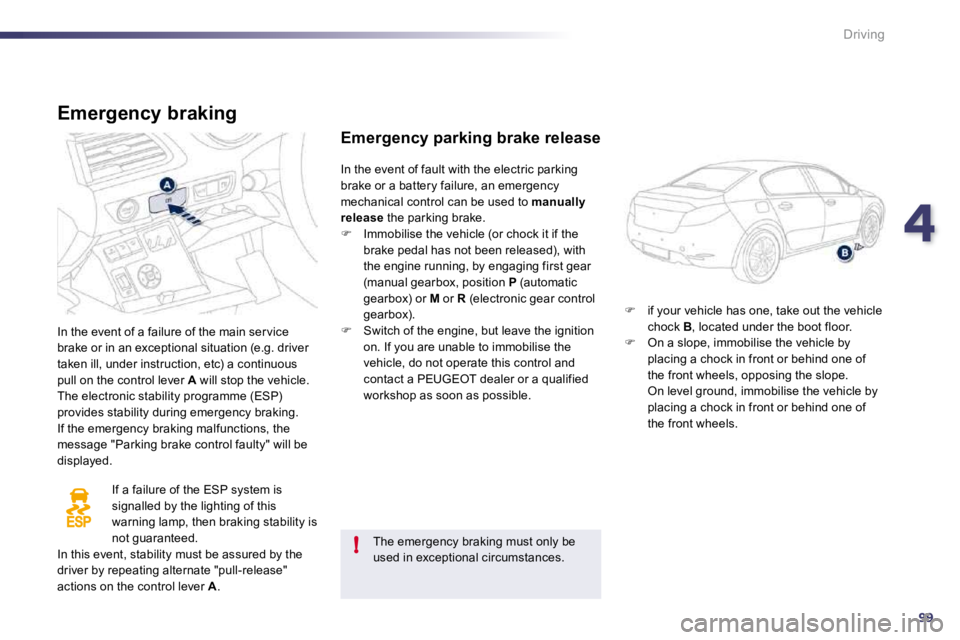
499
!
Driving
Emergency braking
In the event of a failure of the main ser vice brake or in an exceptional situation (e.g. driver taken ill, under instruction, etc) a continuous pull on the control lever A will stop the vehicle. The electronic stability programme (ESP) provides stability during emergency braking. If the emergency braking malfunctions, the message "Parking brake control faulty" will be displayed.
If a failure of the ESP system is signalled by the lighting of this warning lamp, then braking stability is
not guaranteed. In this event, stability must be assured by the driver by repeating alternate "pull-release" actions on the control lever A .
Emergency parking brake release
� if your vehicle has one, take out the vehicle chock B , located under the boot floor. � On a slope, immobilise the vehicle by placing a chock in front or behind one of the front wheels, opposing the slope. On level ground, immobilise the vehicle by placing a chock in front or behind one of the front wheels.
In the event of fault with the electric parking brake or a battery failure, an emergency mechanical control can be used to manually release the parking brake. � Immobilise the vehicle (or chock it if the brake pedal has not been released), with the engine running, by engaging first gear (manual gearbox, position P (automatic gearbox) or M or R (electronic gear control gearbox). � Switch of the engine, but leave the ignition on. If you are unable to immobilise the vehicle, do not operate this control and contact a PEUGEOT dealer or a qualified workshop as soon as possible.
The emergency braking must only be used in exceptional circumstances.